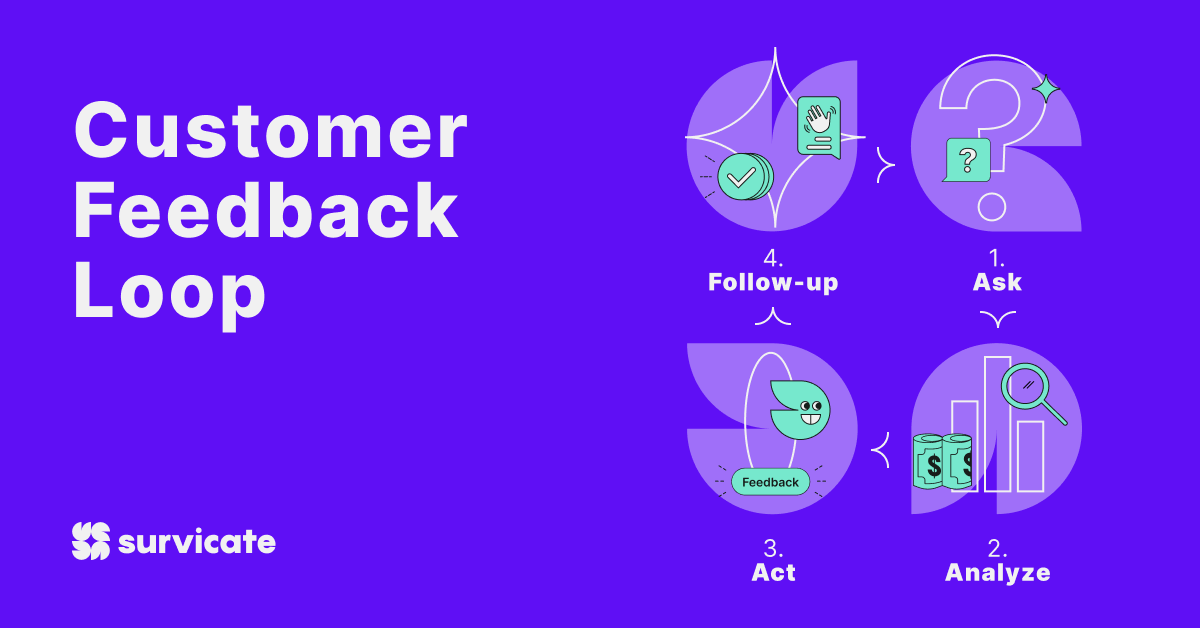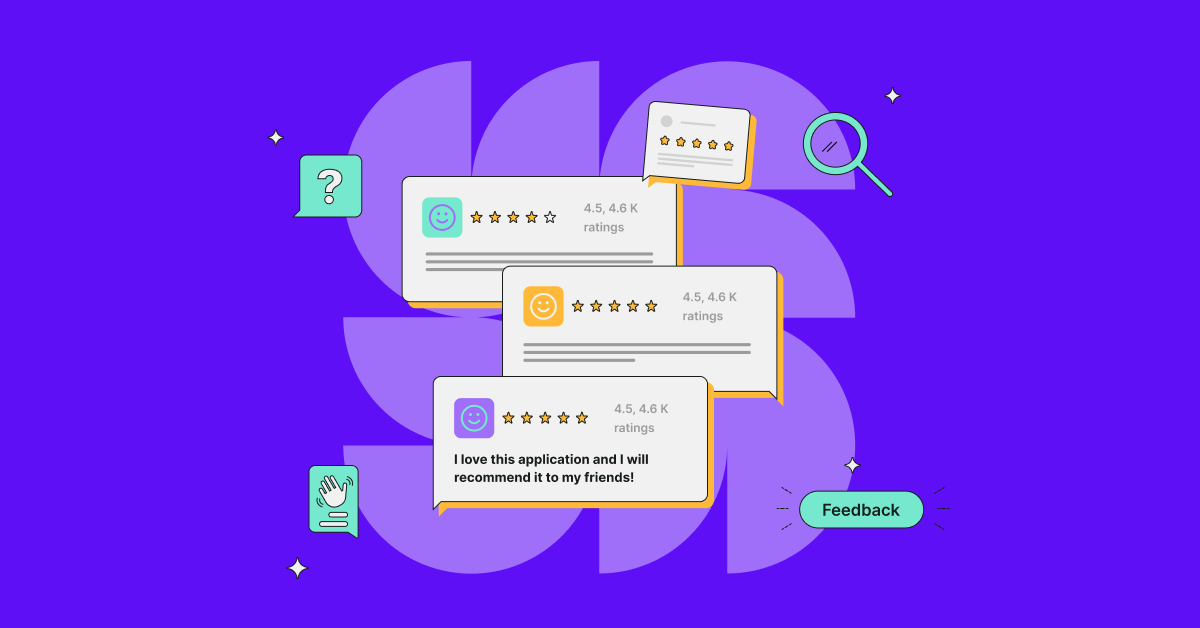Let’s be honest – being a marketer in the digital era can be equally exciting, as nerve-wracking.
It brings to mind the Paul McCartney classic – you either “win or lose” or “sink or swim”.
On the one hand, with thousands of clients and leads just a couple of swipes and clicks away, advertising and collecting feedback has never been so easy.
On the other, for the very same reason, it’s also become horrendously challenging to keep track of everything that goes on once our offer is out in the open.
If you’re missing out on positive opinions, it’s a pity you’re not using them for brand endorsements (and a motivation boost, for that matter).
But it’s a full-fledged tragedy if you’re not aware of (and where) your clients are leaving you negative feedback, and can’t make amends or drive your product strategy accordingly.
 (1).webp)
In the following post, we’ll discuss:
- What type of customer feedback you should be looking out for (hint: it’s not just survey responses and opinions!),
- The feedback channels you should be paying attention to,
- How to instate a sustainable customer feedback management procedure, and which customer feedback tools and tricks you can use.
So, let’s talk about effective customer feedback management. And I’m thinking “level: Jedi master” here.
But first…
The Customer Feedback Loop
Have you ever read about Customer Feedback Loop?
If you haven’t, it represents the way you derive and effectively process customer feedback, so:

Let’s take surveys as an example.
You ask a question, segment respondents, responses and/or questions into groups, create an action plan based on your findings, and follow-up.
So far, so good.
Now, here’s the catch:
You won’t make the most out of steps #3 and #4 if you don’t cross-analyze your survey findings with external feedback.
The point being: If there’s anything better than mastering survey design, it’s mastering and boosting their effectiveness through an understanding of where they stand in the entire feedback ecosystem.
Now, before we proceed to external feedback channels, let’s take a look at the types of feedback you should be reviewed on a daily basis.
Customer Feedback Types
Opinions: Perhaps, the most common (and obvious) type of user feedback. These can be provided in the form of reviews on websites and app stores or as responses to your surveys.
Depending on the way you ask, you can either receive open-ended answers or a choice from a closed list. All of these are fundamental to understanding your audience’s perception of your services.
Feature request: These are most often provided by clients via chat, in-app surveys, or other communication channels. While they’re not an opinion, per se, they can drive your product development process to align with customer expectations.
You will also validate your clients’ priorities and contest them with your own idea of how your product should evolve.
Bug: Technical fixes that customers expect to be fixed.
Walkthrough: Depending on their technical knowledge or understanding of your product, clients might ask your customer support for a live walkthrough. These cases are an invaluable source for creating relevant FAQ/knowledge base articles or making sure they’re not caused by a usability issue. Speaking of…
Usability issue: Site architecture, processes, or elements that cause user confusion. This is the type of feedback you want to use to drive product development or incorporate before any information architecture changes on your site.
Filed complaints: While also a type of user opinion, they’re processed differently from a formal standpoint (i.e. subject to legal terms). If you’ve got a special department for client complaints processing, you should make sure you have access to their database for reference.
Other: Right off, you might think it’s the category for all sorts of junk messages and questionable emails from diamond-heir African royalty in exile.Still, it’s also a place where a lot of your uncategorized/unactionable messages will go to. But, who says that a message you tagged as ‘uncategorized’ won’t make a lot of sense in 6 months, and will once come in handy?
What about the digital touchpoints for all of these feedback types?
Let’s take a look.
Customer Feedback Channels
Emails: They say email is still king, and it’s hard not to agree. A lot of online stores don’t offer live chat, and even if they do, chances are customer topics such as official complaints will still be moved to the more formal channel.
It’s the most universal communication method, and should definitely be on top of your watchlist!
Surveys: No other feedback collection method will help you build trust and customer satisfaction quite like this one (you can test out two of our most popular customer satisfaction survey templates yourself here– NPS surveys and CSAT survey).
Surveys are also unbeatable when it comes to analyzing your responses – you can quantify the answers from closed-ended questions in a built-in analytics tool like our own, or via Google Sheets/Excel. Think – a matter of seconds.
Communication tools: These are becoming more common by the day, especially among SaaS companies. For instance, at Survicate, we offer live chat communication via Intercom to all our users. Simply put, it’s the fastest way to communicate with customer success.
Pro tip: if you’re an Intercom user like ourselves, you should also make extensive use of tags. It’ll help you maximize your feedback management tricks).

Interviews: Regardless if it’s video conferences or live meetings, interviews tend to revolutionize what you previously thought about your company and how it serves its users. Plus, if you use a transcription tool, you can also analyze insights from recordings.
App stores: If you’re an app developer, it’s absolutely crucial that you make sure any negative ratings and opinions are responded to and processed to drive product roadmap. If not, you can easily end up being ‘buried’ in app store results’ lists as unreliable software.
Online opinion sites: Similarly to app stores, some leads will only trust your user opinions/ratings, if they’re on independent sites. Depending on what your product is, these can be e-commerce stores like Amazon, or comparative sites.
Social media: The big start of the past (and current) decade. If you’re not evaluated highly on these outlets, or at least don’t officially respond to criticism, then you’re likely looking towards souring churn rates and a decrease in signups.
Last, but not least, let’s take a look at the tools and methods you can use to make your marketer’s FOMO a distant memory.
Customer Feedback Management Tools
Excel/Google Docs: If you’ve got a lot of discipline (and, let’s be honest, time on your hands), you can do regular searches for your brand mentions, and write down any findings in spreadsheets.
You can also semi-automate this process, and incorporate findings exported from marketing and customer satisfaction tools, such as surveys. If this is your go-to method, then you’ll likely find the next tool immensely helpful.
Brand mention tools: At Survicate, we use Ahrefs to monitor where our site is talked about and linked to. It’s great for making sure you don’t miss an important influencer blog post or a rather unflattering opinion you will want to react to and clarify.
CRM: If you integrate your communication and survey tools, you can create a solid base knowledge on your clients. Still, it won’t work as a feedback management tool, per se, as enrichening lead/client profiles is the main goal.
Messenger platforms: This is both a source of feedback and, to a certain extent, a management tool. You’ll thank yourself later for marking all your customer discussions with specific tags. Why? It enables you to quickly filter your communication logs down to specific threads.
But there’s more to it.With an additional customer feedback management tool, you’ll be able to filter messages not only by threads but also find specific keywords and how they were used in context.
And it’s not just applicable to the thousands of conversations on messenger platforms. We’re talking about being able to search records and incoming messages from all sorts of channels.
Think – email, chat, app stores, comparison sites, and even archived conversations where tags weren’t used in the past, but include the desired keyword.
Here’s where Survicate's Feedback Hub comes into play.
.webp)
Feedback Hub
So, you already know it can do a few impressive tricks when it comes to integrating with your communicator tools and tagging customer feedback.
What else is on the table? Or, maybe even more specifically, what should a comprehensive, 360 customer feedback management tool offer?
According to a Forrester report, there are 4 main activities you should be able to perform through a customer feedback management tool to make sure it aligns with Voice of the Customer programs:
Listening: What are my customers saying about me on all channels?
Interpreting: Making sense of the information collected while listening.
Acting: Based on insights gleaned during interpretation, prescribing and deploying appropriate actions through resolution.
Monitoring: How am I doing? What is my customer satisfaction score? Are the actions I am taking result in loyal customers?
Feedback Hub ticks all the boxes
Here are just some of the things you’ll be able to do in all of the mentioned areas:
- Integrate your communication and customer feedback tools within seconds or upload feedback manually – literally from any source online. You’ll love this if you’re an Intercom user!
- Spot most popular and recurring issues that your customers discuss across all monitored channels.
- Innovate through insights from your audience to drive customer experience.
- Tag relevant people at your company to keep them in the loop.
- Monitor all future mentions, and have them automatically detected and marked with appropriate tags.
- Upload external and archival customer communication, such as interview transcripts.
And that’s just the beginning of where we’re planning to take our customer feedback management platform in the coming months. So stay tuned!
Take the whole Survicate feedback management toolset for a spin with our 10-day free trial now! Also, you can foster your decision by checking our newest ranking of best customer satisfaction tools.

.webp)






.svg)
.svg)
.svg)

.svg)


.svg)







.svg)




.svg)

















.svg)






























.svg)

.svg)
.svg)

.svg)



.svg)






.jpg)
.svg)

.svg)







